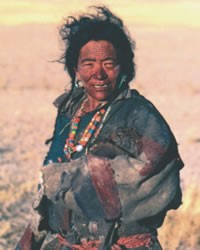Tibetan, Nghari in China

Photo Source:
Copyrighted © 2026
Peoples of the Buddhist World, Asia Harvest All rights reserved. Used with permission |
Send Joshua Project a map of this people group.
|
| People Name: | Tibetan, Nghari |
| Country: | China |
| 10/40 Window: | Yes |
| Population: | 63,000 |
| World Population: | 63,000 |
| Primary Language: | Tibetan, Central |
| Primary Religion: | Buddhism |
| Christian Adherents: | 0.00 % |
| Evangelicals: | 0.00 % |
| Scripture: | Complete Bible |
| Ministry Resources: | Yes |
| Jesus Film: | Yes |
| Audio Recordings: | Yes |
| People Cluster: | Tibetan |
| Affinity Bloc: | Tibetan-Himalayan Peoples |
| Progress Level: |
|
Introduction / History
The inhabitants of the Nghari region are also known as the Chang Tang (Northern Plain) Tibetans. Although they are ethnically Tibetan, they speak a language far removed from other Tibetan varieties. Their lifestyles have changed little over the last thousand years and are still devoid of any technology or machinery.
Western Tibet is a holy site for the followers of the four religions of Buddhism, Hinduism, Jainism, and Bon. Every year, thousands of pilgrims flock to the sacred Mount Kailas, a 6,714-meter (22,021 ft.) peak near Tibet's border with India and Nepal. During the Cultural Revolution (1966-1976) ten of the 13 monasteries in the region were demolished.
What Are Their Lives Like?
The favored kind of burial for Nghari Tibetans is "wind burial." The corpse is cut into small pieces and laid out on an exposed rock for vultures and ravens to eat.
What Are Their Beliefs?
Immersion in one of two holy lakes south of Mount Kailas is thought to release people from their sins for a lifetime. Pilgrims who trek to the top of the 5,640-meter-high (18,500 ft.) Dolma Pass are believed to be born again in the process. Folk Tibetans believe in a hell divided into eight hot and eight cold levels. Sinners are made to suffer until they have worked off their demerits.
The first recorded Tibetan church was built by Jesuit missionaries in Lhasa in 1726. Twenty seven baptized converts and 60 inquirers attended the church. "At the end of April 1742, a new convert named Pu Tsering publicly refused to bow before the Dalai Lama. ... This threw the town into an uproar. Twelve of the Christians were flogged with 20 lashes each. The missionaries fled to Nepal, but their church was attacked by a mob who destroyed everything except the church bell." Today there are no known Christians among the Nghari Tibetans.
What Are Their Needs?
Like people everywhere, the Nghari Tibetan people need to allow the loving Savior to direct their lives. They need his forgiveness for sin.
Prayer Points
Pray for the Lord to intervene in their families, calling people to his side.
Pray for loving workers.
Pray for their hearts to be drawn to the Lord of lords.
Pray for a church planting movement to thrive in their communities.